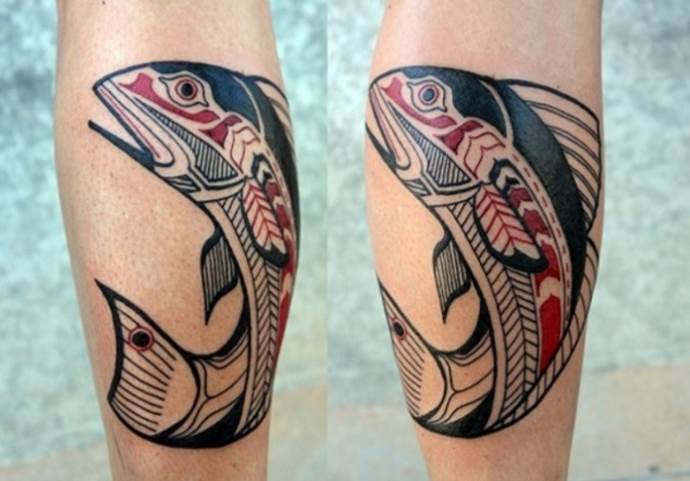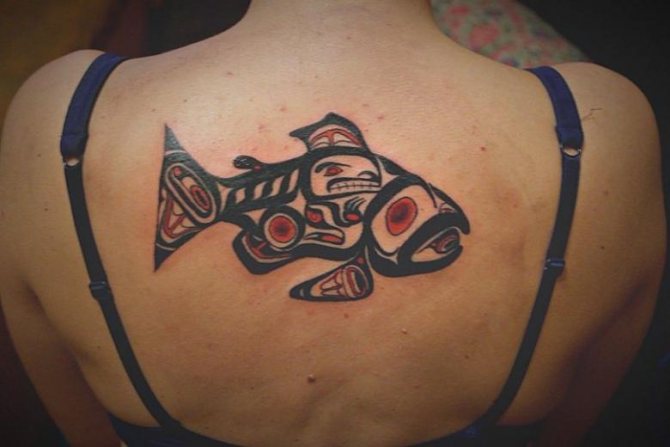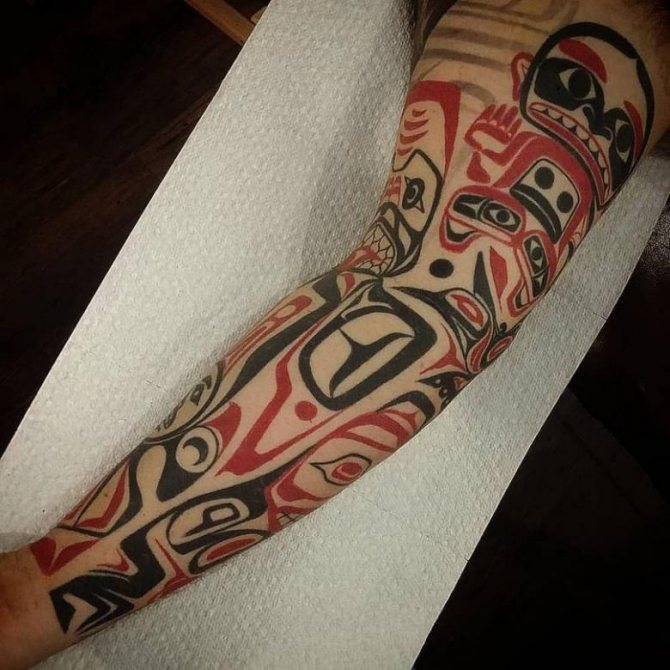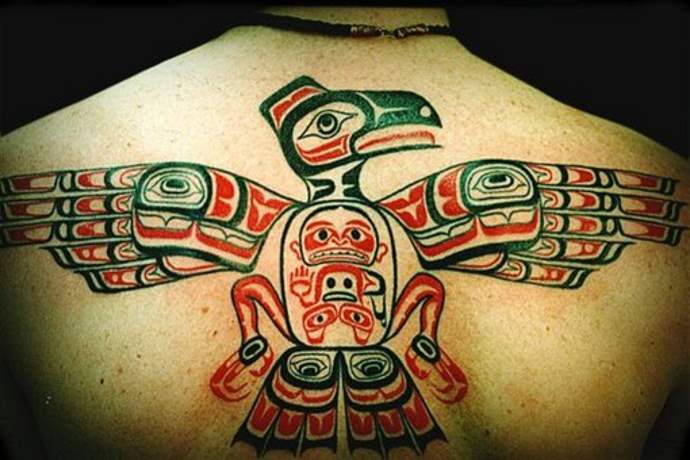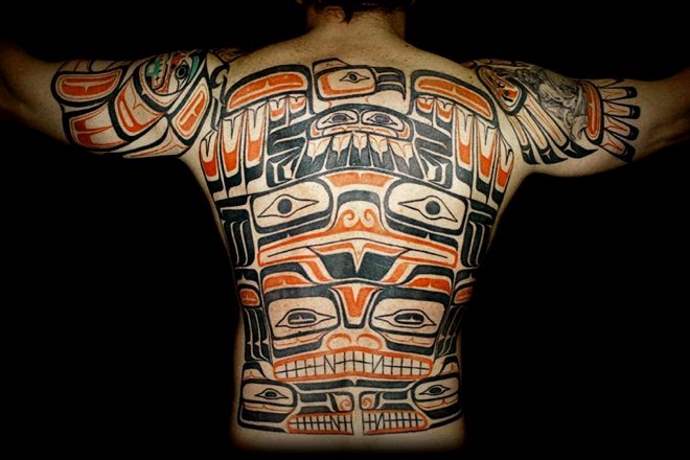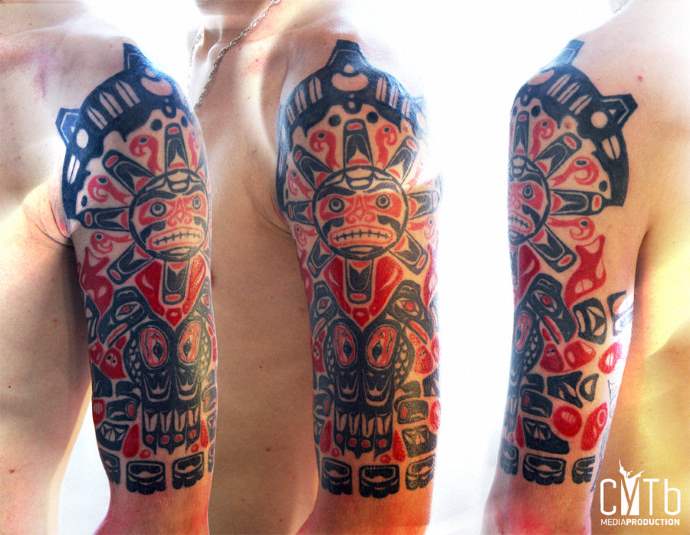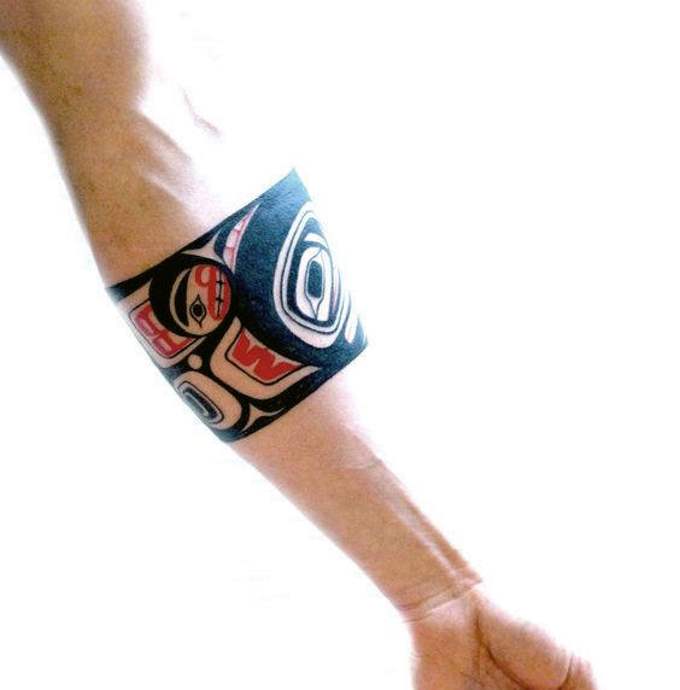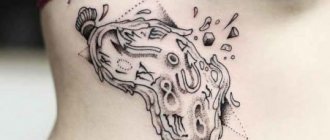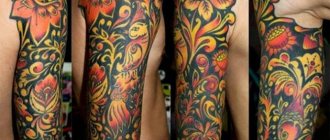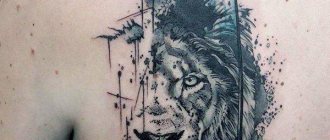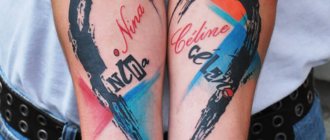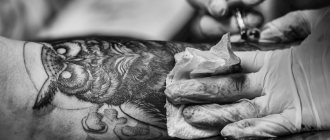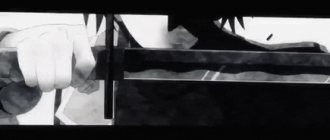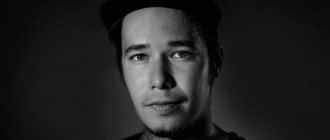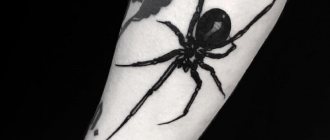Elena Lavrentieva
City: Moscow Work experience: In the profession since 2008. Directions: I work in the directions of ornament: Haida, Polynesia. As well as Japan (Oriental), Dotwork and blackwork. Achievements: Winner of the St. Petersburg Festival 2015 in the category "ornamental female tattoo". I promote a rare style of tribal ornamentation Hyde, or rather formline. Main Principle: The main principle is that this tattoo should fit the place in size, repeat the anatomy of the body in shape. I do not like to be shallow, as tattoo should look good not only from close up, but also from far away. Favorite work:
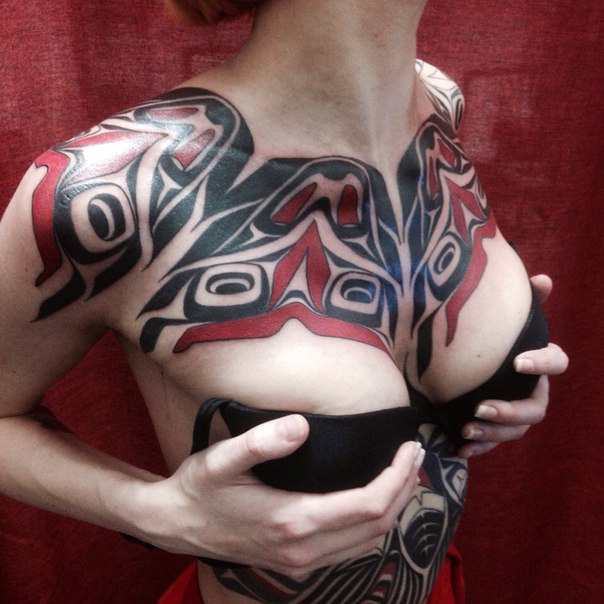
Characteristics
Hyde tattoos are easily distinguished from other ethnic styles by the following features:
- the predominance of four basic colors: black - the personification of the earth, red - blood, green - green, blue - sky (the presence of other colors is excluded, as the whole concept of the drawing collapses);
- geometric shapes and smooth lines;
- tattoo sketches have a special symbolic meaning.
- saturated and bright images, sometimes abstraction;
- Drawings of totem animals, birds, fish;
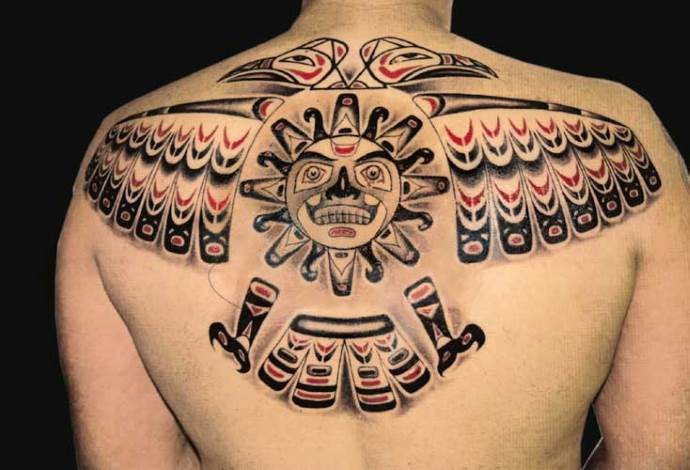

Haida tattoo will suit people who appreciate authentic art and seek to express their individuality. It is believed that body art in this style brings its owner rapid changes and unexpected joyful events. Tattoos with totem animals can serve as a powerful amulet, protecting from trouble and the negative influence of others.
Interview with Elena Lavrentieva: let's talk about the peculiarities of the unique Hyde style
Today we will get acquainted with the unusual, rare and very interesting style of Haida. Haida style tattoos are a kind of tribute to "tribal painting", because this style originates from the Indian tribes. What is its peculiarity? Why is the style not so popular, despite its originality? About all this and about much more we will talk today with a wonderful master Helena "The Bee" Lavrent'eva. Hello Lena, before we plunge into the world of the amazing style Hyde, tell us about yourself. First, may I ask, why you became a Bee?
Hi! They started calling me Bee when I started braiding my dreadlocks. That was when I graduated high school. They waxed my dreadlocks for a while, and they kept sticking out in different directions. My bangs got short dreadlocks and I couldn't get them down, they stuck out like a bee's tendrils. That was the secret. Well, in terms of work I justify the name, if I am passionate about something, I will work like a bee. But like everyone else, there are times when I don't want to do anything at all.
How life has brought you to the tattoo industry? As passed a way of becoming the master?
When I was 14 my friends brought me to the studio "Black Fly", they spent their free time there. It was an interesting hangout, and I was a frequent visitor there as well. That's how my introduction to tattoo culture began. I started getting piercings and got my belly button pierced at half of school during recess. At some point it dawned on me that I wanted to work in a tattoo parlor. My friend, my master and teacher Sergei Mysh, helped me get a job at the tattoo 3000 warehouse. I worked with equipment and paint. Worked there for a year, then in the warehouse and in the "Tattoo Age" store. Tattooing seemed like a daunting task, but then I had the courage to take the machine in my hands and off we went. It's an unimaginable feeling. It's adrenaline, responsibility for trust, and pleasure. I can't describe it all. It took a long time before I started doing my sketches in public. I made a lot of broads and partaks, alas, there's no way around it.
Is it difficult to combine your personal life with your work in such an interesting but busy field?
I'm a mom, and yes, it can be difficult. I worked from home for a long time before my daughter grew up. Now she goes to kindergarten, and I have a babysitter to help me. So I've been able to do everything. Getting out to hang out and go on trips is still a bit difficult, and it is rare. I spend all my free time with the baby and drawing.
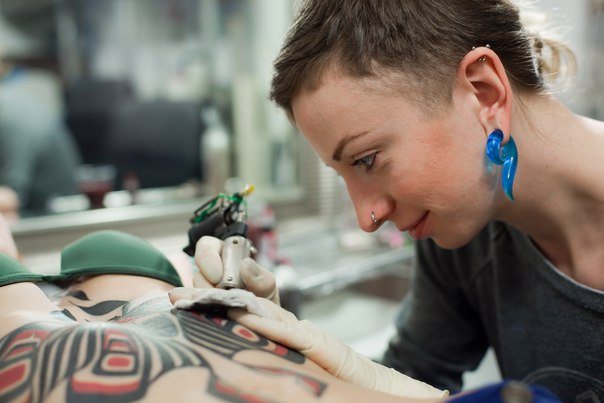

Photographer:
Evgeniy Zarenok.
How did you get acquainted with Hyde style? How did it "caught" you?
Why is not popular Hyde style? Just not enough information! Everyone knows about the existence of beautiful totem poles, but few know about their origin. The only person who has seen tattoos like this is Anthony Kiedis from RHCP. I was interested in this style and I started digging, I could not find anything, except that this style is called Haida. I was looking for a master for my tattoo for two years, it was a very difficult task. But now with the advent of the Internet, there are a lot of opportunities. The Haida is just one of many tribes on the coast and islands in western Canada and Alaska. But the name has become a household name. I was hooked by the specifics of the shapes and lines in this style. It's very geometric and fluid at the same time. It's very natural, like calligraphy. It looks amazing up close and from a distance, you can stylize any shape, in general it's perfect for tattoos.
Can you tell the story of the origin of the Hyde style tattoo in the world?
Any style of tattooing has its origins in tribes. Humanity has gravitated toward body modifications, whether it be tattoos or piercings, since the dawn of time. This is how a person's status and occupation were determined, and how initiation ceremonies took place. Sailors "spread" tattoos around the world. This is how the traditional American style of Oriental-Japanese tattoos and drawings by sailors themselves came into being. And Haida was brought to us by the Russian colonizers of Alaska. There are quite a lot of pictures preserved, because it was relatively recent, 200 years ago. In the Kunstkammer we can see the attributes of these tribes. Tattoos in these tribes were worn mostly by the nobility.
Why is the style called "Haida"?
It is not very correct to call this style Haida. These are dozens of tribes that still inhabit the islands and coasts of Canada and Alaska to this day. Such as the Tlingits, Tsimshians, Kwakiutli, Haida, and many others. In books about their art, the style is called Formline. I think that is the most appropriate definition for the style, so as not to offend anyone. The Indians themselves are very zealous about it. They are now Canadians and Americans, and almost everyone has an iPhone. I communicate with some of them on Facebook and Instagram. Among them there are both ardent opponents of what we tattooers do and amateurs. Some think we are stealing their culture, some, on the contrary, support it. In my publications, I call this style Formline, and it suits everyone.
Taking into consideration that this style is not very popular, do you know many artists who work in this style?
During my search of information, it turned out that the masters of tattooing who specialize in this style can be counted on the fingers. There are a few famous artists in Canada: Jean Michel Manutea and Deano Robertson, Mikel tattoosangha. In America - Jerry Ware, in Alaska - Dave Lang. In Europe - Collin Dale, and a few more ornamental artists who also do the Hyde thing. There are not a lot of us in Russia too: Sergey Mysh, for example, started doing this style in the 90s, I've seen some works by Dmitry Babakhin and Maxim Kokin. I even found a couple of Japanese. I created a Facebook group: Formline tattoo Art, where I brought them all together.
It's so great that you found and gathered like-minded people! By the way, what is the meaning of tattoo hides? Can they be perceived as tattoo amulets?
This style mostly uses animal and nature themes. Tribes had various animals depicted on their houses and totem poles. It's kind of like a family tree, a history of the clan. Initially some were divided into 2 clans of wolves and crows, then the families were called frogs, bears, etc., as family names. Events from fairy tales and legends and wars were also depicted. They had shamanism, so the concept of "spirit guides" was common. This is when a person identifies with an animal or considers a certain animal as his patron. They had a cult of the bear, tattoos in the form of a bear were common. Everyone can put their own meaning into it, whether it's a story or a patron spirit - a talisman.
Why are Hyde tattoos created in two colors, black and red? Can other colors be present in a Hyde style tattoo?
The main colors in this style are black, red and blue. It's a kind of flag. Each color has its own meaning - the elements. Haida used mainly black and red, the Tlingit - black, blue and yellow, and other peoples also slightly different colors. The main one was always black. Black and red look good in tattoos. And before the colors for tattoos were not so rich in palette, so these colors especially caught on.
Among the Haida tattoo, what images are more common - patterns or animals?
Most often, of course, animals, but often abstract images as well. This way you can style anything, creativity has no limits.
Why do you think connoisseurs of tattoos prefer such styles as Haida, ethnics, Polynesia, ornamental, etc. in general?
It's close to the origins, the roots. It's a classic that will always be relevant, in any age or society. No gopnik is going to ask you to answer for the suits.
Do you often take part in various festivals, conventions?
Every year I take part in festivals, as a spectator and participant. This year I will be at the St. Petersburg festival, on June 10-12, as a participant. There will be many artists from Europe and I want to meet them personally.
Do you like to travel?
Of course I do, but I don't always have the opportunity. So far I haven't been many places - I went to the USA, drove around a few states and was in Barcelona. My dream is to go to the states again and drive through Canada to Alaska to places where Indians live, and meet the artists and tattoo masters working in the Hide style in person.
What inspires your creativity?
Everything around me: nature, people themselves tell me what to draw.
What are your plans for the future? Don't you plan to start teaching?
I plan to continue to create, travel more, find a quiet place in nature and live there. The city is very tiring and irritating. I have had and still have several students, not everyone is serious about tattooing. Many want to try it and see if it works. But you have to devote all your time to this in order to start getting it right. Still it is necessary to understand that the person will spend the rest of his life with what you draw on him, it's a big responsibility. And people often want what they will regret, you need to be able to talk them out of it. It's not just earning "dough" on the inscriptions, characters and kitty cats (not without that, of course), everyone wants to eat. All I can teach you is technique, and then it all depends on the intention and practice.
Finally, let me thank you for the conversation. And wish you luck and creative development!
Thank you! Good luck to you too!
Interviewed by: Alexandra Pitomtseva
Choice of drawing
Haida is mostly expressed in animal subjects:
- eagles, falcons, crows;
- owls, hummingbirds;
- whales (blue whale);
- bears, wolves;
- chameleons;
- boars, hares;
- deer, elk, horses;
- dolphins, sharks, turtles, piranhas;
- feathers and beads, bracelets;
- Sun, moon, stars.


Stuffing is done approximately in such places as the scapula, the whole chest (especially if it is a bird with open wings), the sternum, forearms, ribs, collarbones. Often the tattoo is done in the form of a sleeve - from shoulder to forearm, as well as on the sides.
The color palette is very small. Basically they use one or two colors or a combination of four basic colors: black, red, blue, green.
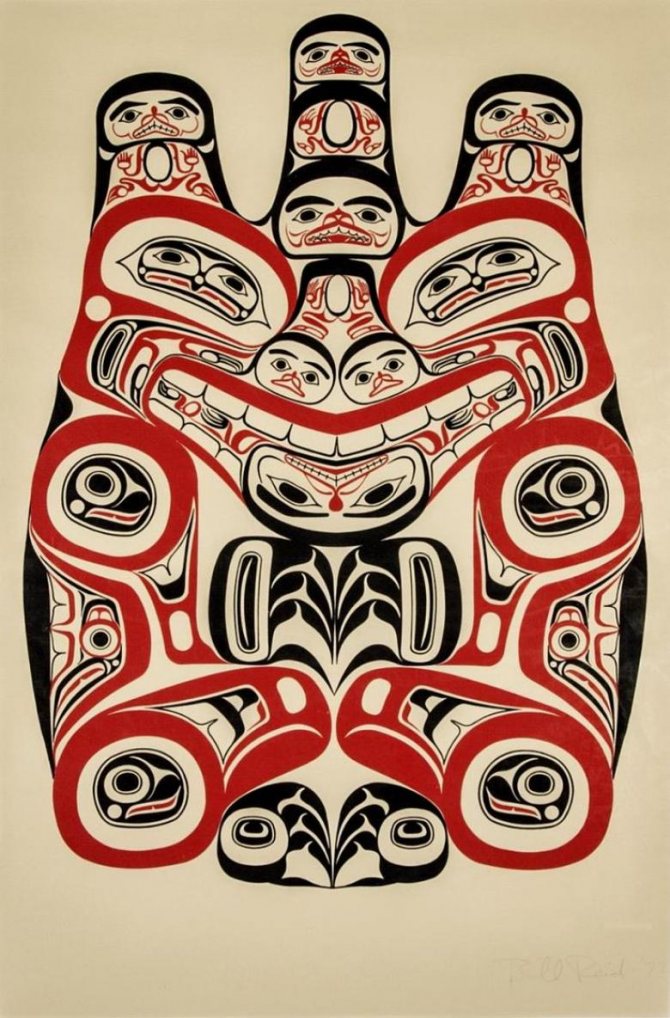

Meaning is played by every detail, including the color:
- red means blood, the power of nature and kin;
- Black is earth and power;
- blue - the patronage of heaven;
- Green is the wealth and power of nature, it is a symbol of life.
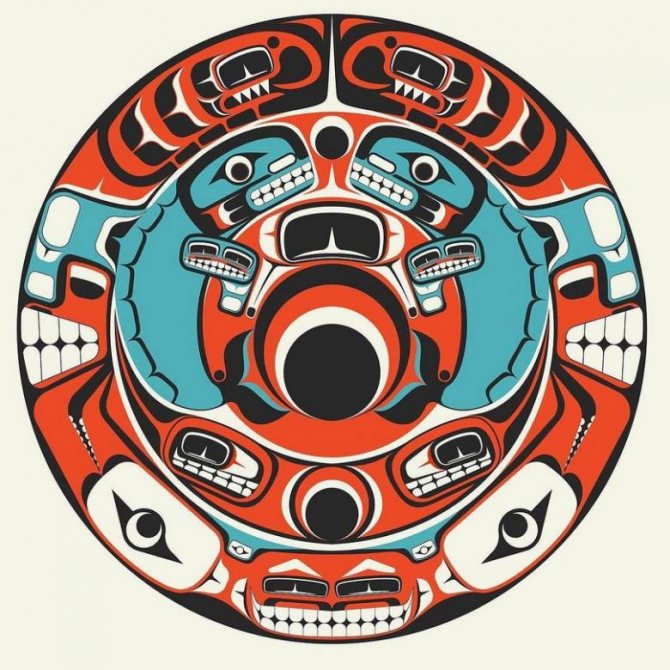

In combination, these colors embodied all the cosmic elements that give life and magical power to all things.


Hyde style tattoos by Elena Lavrentieva:
Who it suits
The Haida direction is a classic of the art of body painting and will never go out of fashion. Such a drawing, as well as tattoos in the style of ethnics, ornamental, Polynesia, has no time limits and age restrictions. He is suitable for adult men and women, young people, representatives of subcultures. The advantage of this technique is that in applying the tattoo photo you can choose any. A professional experienced master will stylize the image you like under the style of Hyde and give it a symbolic meaning.
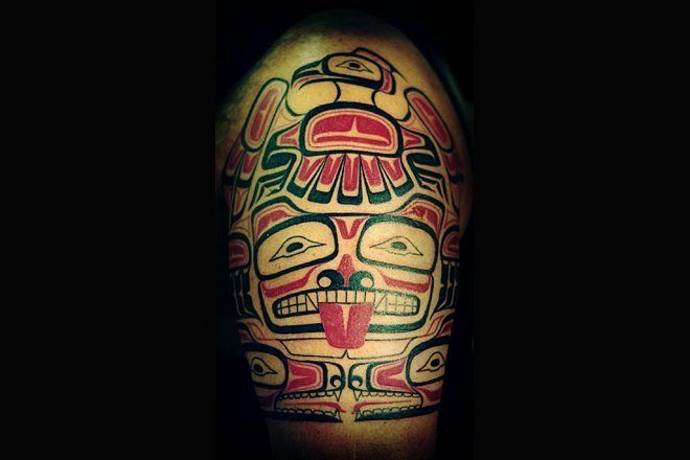

Usually tattoo sketches are large enough, so popular places of drawing are back, shoulder, chest, arm and forearm. With the right work of the tattooist, the composition will look spectacular from any distance.
Watch a video on the subject
